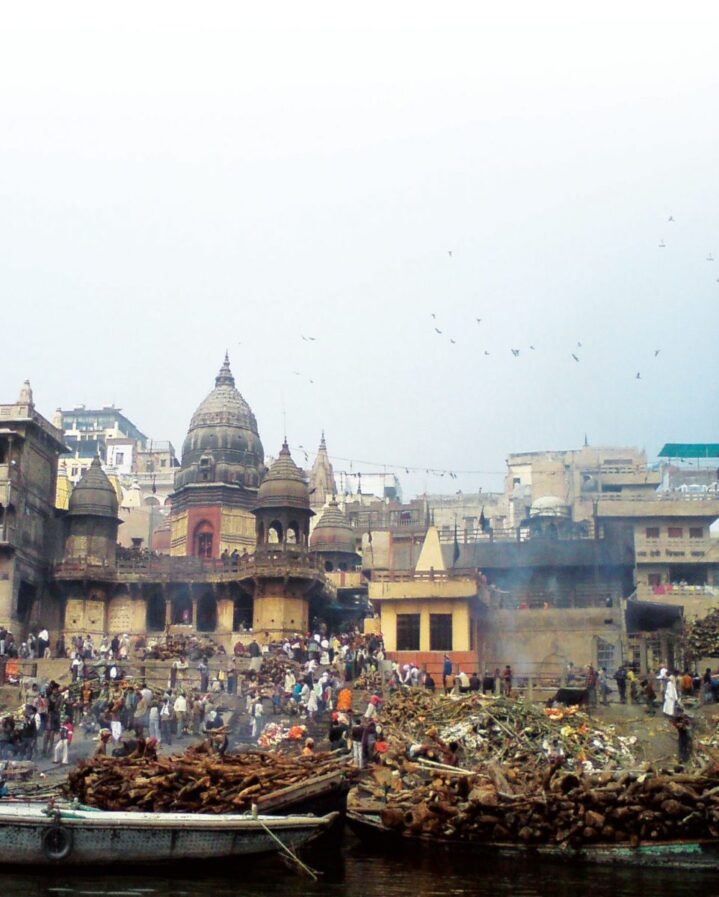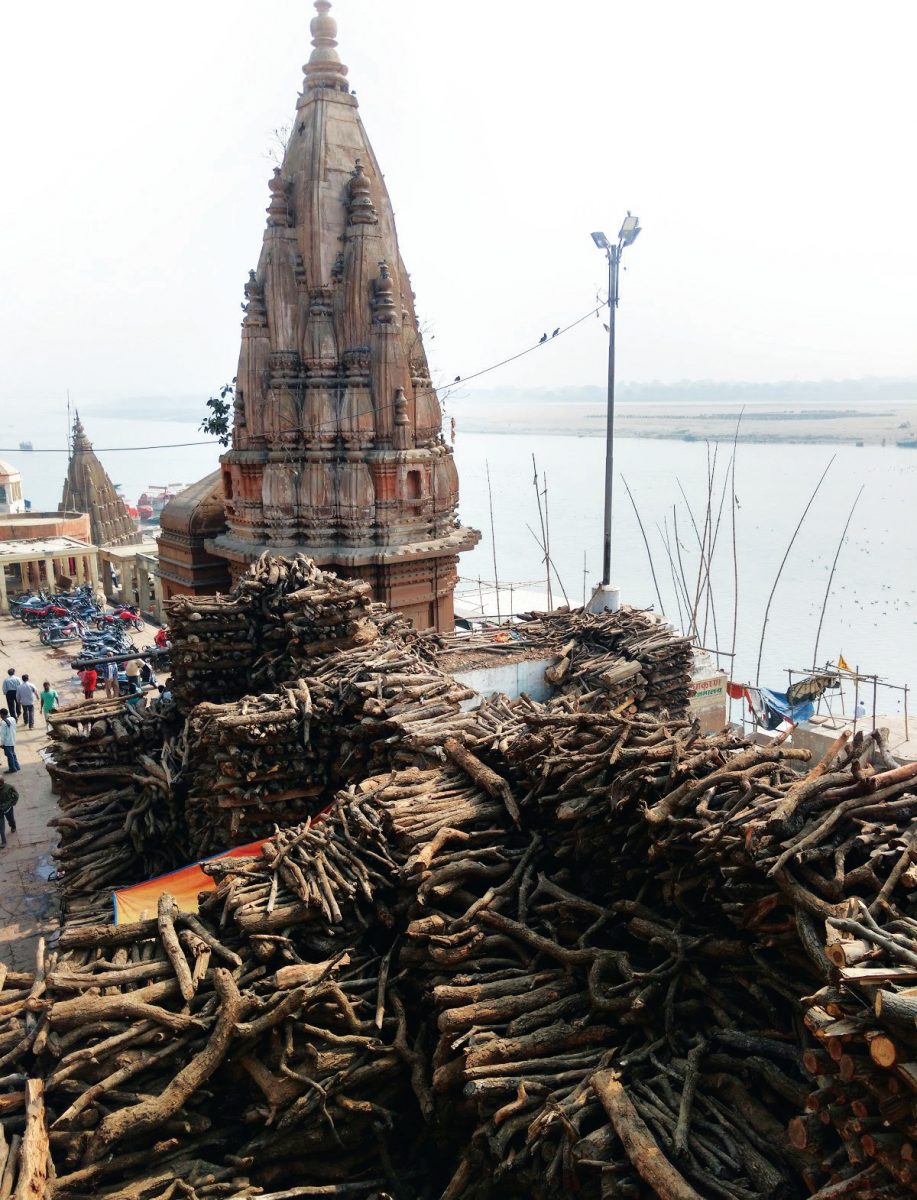
The fires that cleanse the soul
On the west bank of the River Ganges, in Uttar Pradesh, sits Varanasi, the most sacred Hindu city on earth. The river, ‘Mother Ganga’, is itself considered to be a goddess; people come from around the world to bathe and drink from her holy water.
As a tourist, it was difficult believing in any possible health or spiritual benefits, as the occasional body drifted through the littered water, past the goats and water buffalo wading in the shallows. Along the river there are many giant stone stairways (gahts) leading up to the city, and two of these are locations for cremations. As you stand on the old stone balcony overlooking the smouldering pyres at Manikarnika Gaht, if the intense heat haze and white smoke, blur what’s going on in front of you, it only adds to the primeval scene that has remained unchanged for centuries. Nobody knows for sure how long the hallowed fires have been burning here, probably for much of the 5,000 year history of the city. On an industrial scale, over 250 bodies are processed every 24 hours in a relentless conveyer belt of spiritual farewell, dispatching earthly bodies and liberating souls.
Hindus aim to be cremated within 24 hours of death, and it’s the expressed wish, of those who can afford it, to make that happen at one of the two sites in this holiest of Indian cities. If you die here, it’s believed that you break the cycle between life and death, avoiding rebirth where you might come back as a dog or a prawn. Around 9 million Indian Hindus die every year, and many make it here, before or after death, for the chance of a straight passage to Moksha (heaven).

The dying and the dead arrive by road, boat, train and air, and as you walk towards the edge of the river, the crowds grow. Tourists like me do a very bad job at blending in, mainly because we are in awe at everything before us. There are humble buildings along the river where the dying can spend their final hours, which often turn to days or weeks; such is the unpredictability of the moment. That said, when death comes it’s a joyous occasion, a time for the family to celebrate as that person’s final goal is achieved.
If this is your first visit to an Indian city, the main thing that hits you is the amount of cows (and a sprinkling of goats and dogs) that wander aimlessly everywhere. These holy animals go where they please, often sitting, blocking the traffic, raiding the many vegetarian food stalls or seemingly having fun running at high speed through the narrow streets as people dive for cover. It’s no different at the cremation site, where the cows have an appetite for the funeral flowers, even before they are stripped from the bodies.
 The ‘Doms’, a sub-caste of the ‘untouchables’, work on the cremation site and because of superstition, they alone come into physical contact with the dead. Even in death the ‘untouchables’ themselves are separated, with different levels in the gaht for each caste. When the male members of the family arrive with their shrouded relative, all goodbyes have been said by then, and the body is dressed in flowers before being carried down to the river’s edge. There, they are ceremoniously immersed, purified by ‘Mother Ganga’, and then left for several hours to dry. Enough mango wood is purchased and this is carefully weighed out from the massive stacks that dwarf many local buildings. It can take around 300kg to cremate the average body and nobody wants to look mean with their wood or see the result of not having enough, when ashes along with charred remains are raked into the river. When the pyre is ready, the flowers are removed and the mortal remains laid on top of the wood, with extra branches laid gently over them. This final weight of wood is necessary to prevent a more macabre sight as it prevents the body ‘sitting up’ as it distorts in the heat. With the feet pointing south towards Yama, the God of Death, and the head to the north facing Kubera, the God of Wealth, the pyre is ready.
The ‘Doms’, a sub-caste of the ‘untouchables’, work on the cremation site and because of superstition, they alone come into physical contact with the dead. Even in death the ‘untouchables’ themselves are separated, with different levels in the gaht for each caste. When the male members of the family arrive with their shrouded relative, all goodbyes have been said by then, and the body is dressed in flowers before being carried down to the river’s edge. There, they are ceremoniously immersed, purified by ‘Mother Ganga’, and then left for several hours to dry. Enough mango wood is purchased and this is carefully weighed out from the massive stacks that dwarf many local buildings. It can take around 300kg to cremate the average body and nobody wants to look mean with their wood or see the result of not having enough, when ashes along with charred remains are raked into the river. When the pyre is ready, the flowers are removed and the mortal remains laid on top of the wood, with extra branches laid gently over them. This final weight of wood is necessary to prevent a more macabre sight as it prevents the body ‘sitting up’ as it distorts in the heat. With the feet pointing south towards Yama, the God of Death, and the head to the north facing Kubera, the God of Wealth, the pyre is ready.
The head mourner, a male relative dressed in white, lights the fire having accepted flaming kusha twigs from the Doms. The body becomes an offering to Agni, the God of Fire, and after some time, as the heat increases, a loud ‘pop’ can be heard as the skull explodes, releasing the soul into the flames for cleansing. The Dom’s keep a watchful eye, poking and raking the steaming, spitting remains where necessary, on and off for about 6 hours until only ashes remain. At anytime there could be 20-30 bodies, all at various stages of the process, from the first ritual river dipping to the point of raking the ashes into the Ganges, their final resting place.

Some people avoid cremation completely and are buried instead. A good thing for children under the age of two and holy men, who’s souls are considered pure and not in need of cleansing. Not so good for criminals and those who’ve committed suicide, their souls considered too black to be cleansed by fire. As I walked away from the flames, through the white smoke at Varanasi, I thought of my father who had become a Buddhist in later life. Had I let him down? His funeral in England had been so commercial, synthetic and void of meaning to me, with the silk lined coffin, big fancy cars and men in black suits. He would have loved to have made his exit here at Varanasi, where it all seems so much more ‘believable’, that indeed there is a better place waiting for us all.



